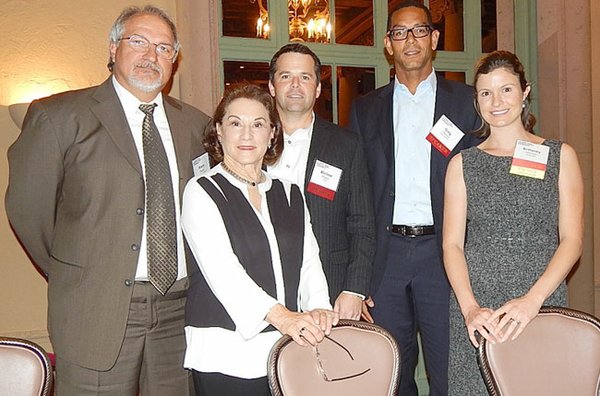THE PANEL: From left to right: Marty Bailey of American Apparel, Ilse Metchek of the California Fashion Association, Michael Rosen of Velvet, Greg Harvey of Avery Dennison and moderator Brittaney Kimmel of Chase Bank
MANUFACTURING
Apparel Makers Tackle the Task of Finding Skilled Labor in Los Angeles
Apparel makers who want to manufacture more merchandise in Los Angeles have a challenge. It’s hard to find good, skilled laborers who are in the country legally.
That was a problem that hit American Apparel in 2009 when immigration officials forced the Los Angeles maker of T-shirts and other clothing to fire 1,800 workers who couldn’t produce valid documents showing they could legally work in the United States.
Now, American Apparel is spending up to one year to train its new workers to staff the company’s array of machinery and become a skilled sewing operator at the company’s huge factory on the edge of downtown Los Angeles. “There is a plethora of skilled labor in Los Angeles, and I can’t touch them. For us, immigration reform is a key subject,” said Marty Bailey, American Apparel’s chief manufacturing officer. He said the company, a totally vertical operation, employs 6,000 workers in Los Angeles County and another 4,000 elsewhere.
Despite the challenges, the largest U.S. apparel factory is dedicated to keeping its manufacturing in Los Angeles. “The beauty of manufacturing in Los Angeles is you get to see the faces of your employees,” Bailey said.
Bailey was speaking on a panel about apparel manufacturing and fashion at the West Coast Manufacturing Conference, held on April 30 at the Millennium Biltmore Hotel in downtown Los Angeles. Joining him on the panel were Ilse Metchek, president of the California Fashion Association; Michael Rosen, chief financial officer at Velvet; and Greg Harvey, director of retail at tags and labels maker Avery Dennison.
American Apparel is a rare case in the local apparel industry. It does everything from concept to finished product. In Los Angeles, most apparel makers use outside contractors to cut and sew their garments, which has its own set of problems.
Metchek pointed out that California is the only state where apparel makers and retailers are held responsible for the contractors they hire to pay workers the minimum wage and overtime as well as follow labor laws. This is spelled out in AB633, or Assembly Bill 633, legislation passed in 1999 to combat sweatshop conditions in the garment industry. “Ninety-nine percent of our industry is contractor-based,” Metchek said.
Rosen of Velvet, a Los Angeles manufacturer that started out in 1997 making T-shirts in Los Angeles and has extended that to casualwear, said there has been lots of talk about returning apparel manufacturing to Los Angeles, but it has its challenges because working with contractors can carry its own set of liabilities in California.
To mitigate being caught up in a contractor’s missteps, he suggested that apparel makers either hire an outside firm to verify that a contractor is following labor laws or do it themselves by asking a host of questions and asking for detailed paperwork to prove contractors are paying their employees a fair wage. “Your objective is to limit your financial risk and establish a paper trail that demonstrates you have done what is necessary to ensure compliance,” he said. “Make sure your contractor is registered with the state and that they have worker’s compensation insurance.”
He advised manufacturers to pay a fair price for garments so contractors can afford to pay the minimum wage and overtime as well as make a reasonable profit. “If you don’t enter with that attitude, there is trouble down the road,” he said.






















